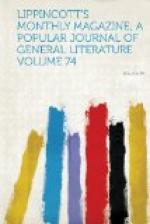The Dee is more a Welsh than an English river. It rises in the bleak mountain-region of Merionethshire, the most intensely Welsh of all counties, above Bala Lake, which is commonly but incorrectly called its source. Thence it flows through the Vale of Llangollen, famous in poetry, and waters the meadows of Wynnestay, the splendid home of one of Wales’s most national representatives, Sir Watkin Williams Wynn, and only beyond that does it become English by flowing round and into Cheshire. On a very tiny scale the Dee follows something of the course of the Rhine: three streamlets combine to form it; these unite at the village of Llanwchllyn, and the river flows on, a mere mountain-torrent, past an old farmhouse, Caer-gai, lying on a desolate moor at the head of Bala Lake, and through the lake itself, after which its scenery alternates, like the Rhine’s below Constance, between rocky gorges and flat moist meadows dotted with hamlets, churches and towns. Bala—otherwise Lin-Jegid and Pimblemere ("Lake of the Five Parishes")—has some traditional connection with the great British epic, or rather with its accessories—the Morte d’Arthur—of which Tennyson has availed himself in Enid, mentioning that Enid’s gentle ministrations soothed the wounded Geraint
As the south-west that blowing
Bala Lake,
Fills all the sacred Dee.
Arthur’s own home, according to Spenser, was at the source of the Dee: Vortigern’s castle was near by on the head-waters of the Conway; and “under the foot of Rauran’s mossy base” was the dwelling of old Timon, where Merlin came and gave to his care the wonderful infant who was to become the Christian Hercules of Britain. “Rauran” is the mountain which in Welsh is Arran-Pon-Llin, and which with its rocky shelves overlooks the yews of Bala’s churches and the unaccustomed shade trees which the little town boasts in its principal streets. The lake, quiet and hardly visited as it is now, has great resources which are likely to be called upon in the future, and a survey was made ten years ago with a view of supplying Liverpool, Manchester, Blackburn, Birkenhead, etc. with water whenever a fresh demand for it should arise. This would imply the building of a breakwater at the narrow outlet of the lake, the damming up of a few mountain passes, and the “impounding” of a tributary of the Dee below the lake—the Tryweryn, which has an extensive drainage-area; but these works are still only projected.




